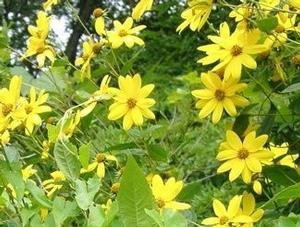New Moon Nurseries
Helianthus divaricatus
Woodland sunflower
Native to North America
FIRST IMPRESSIONS: Helianthus divaricatus is an upright rhizomatous perennial wildflower. The leaves are lance shaped and opposite. From mid-summer until autumn plants are adorned with terminal clusters of clear yellow 2-3” daisies. Plants thrive and form colonies in sunny or partly sunny sites with dry or moist sandy soil.
HABITAT & HARDINESS: Helianthus divaricatus occurs in the eastern North America in Quebec and Ontario and from Maine to the Florida panhandle and west from Wisconsin to Oklahoma.
Habitats include dry open woods, sparsely wooded bluffs, savannas, open sandy or rocky woodlands, limestone glades, hill prairies, moist to dry sand prairies and roadsides. This sunflower occurs most often in fairly dry uplands and occasionally in moist sandy habitats.
Plants are hardy from USDA Zones 5-9.
PLANT DESCRIPTION: Helianthus divaricatus is an erect branched perennial with smooth stems and long creeping rhizomes.
Leaves are sharply pointed and 2-6” long. Blades can be lance shaped or ovate with smooth margins or scattered teeth. The leaves are arranged in opposite pairs. They have a flat (truncate) base and can be sessile or have very short petioles.
Stems terminate in numerous 1-3” flowerheads that are held on slender stalks. The heads consist of 8-15 light yellow ray florets surrounding a golden cluster of disc flowers.
Blooming occur for about 2 months during summer. The clear yellow daisies glimmer in dappled shade. Tan clusters of achenes appear when flowering has finished.
Plants grow up to 6’ tall with 1-3’ spread.
CULTURAL & MAINTENANCE NEEDS: Helianthus divaricatus naturalizes readily in open woods through most of the United States. Plants are easy to grow in average or dry soils in part sun or part shade.
This sunflower tolerates drought and will grow in loamy, sandy or rocky soil. In moist sandy soils, plants will tolerate full sun.
Plants can spread vigorously from rhizomes and may be too aggressive for small gardens. In natural areas, plant populations increase dramatically following controlled burns which suppress competitive woody species.
This species is pest resistant but may be occasionally nibbled by rabbits and deer.
LANDSCAPE USES: Masses or Groups of Helianthus divaricatus provide a lovely floral display that illuminates the autumn Shade Garden. This sunflower is a good choice for a Wildlife Garden or Meadow. Plants are also used as Butterfly Nectar Plants, Butterfly Host Plants and Cut Flowers. This species has Showy Blooms and is appropriate for Cottage Gardens, Water-wise Landscapes, Low Maintenance Plantings, Perennial Borders and Roadsides.
COMPANION & UNDERSTUDY PLANTS: In lightly shaded gardens try pairing Helianthus divaricaus with Aquilegia canadensis, Aster macrophyllus, Carex pensylvanica, Coreopsis lanceolate, Heuchera americana or Solidago caesia.
Helianthus decapetalus could be substituted in some situations. The two have similar flowers and cultural requirements.
TRIVIA: The flower nectar and pollen appeals to honey bees, native bees, beneficial wasps, pollinating flies, butterflies, skippers and beetles. At least 6 species of specialty bees (that only pollinate Helianthus spp.) visit the flowers. Helianthus divaricatus hosts caterpillars of checkerspot butterflies, painted lady butterflies and several moths. Seeds are eaten by several types of gamebirds, songbirds and by small mammals. Mature colonies provide cover for many kinds of wildlife.
Helianthus divaricatus can be differentiated from other native sunflowers by its relatively smooth stems and very short or non-existent leaf stalks.
Height:
6 ftSpread:
1-3 ftUSDA Hardiness Zone:
5-9Bloom Color:
YellowHelianthus divaricatus Characteristics
Attracts Wildlife
- Butterflies
- Songbirds
Attributes
- Naturalizing
- Drought Tolerant
- Dried Flower
- Cut Flower
Exposure
- Partial Shade to Full Sun
Deer Resistant
- Deer Resistant
Flowering Months
- July
- August
Foliage Color
- Green
Juglans nigra Tolerance (Black Walnut)
- Yes
Soil Moisture Preference
- Moist to Dry
Interesting Notes:
For more information on this plant, visit the USDA PLANTS Database: http://plants.usda.gov/java/profile?symbol=HEDI2
